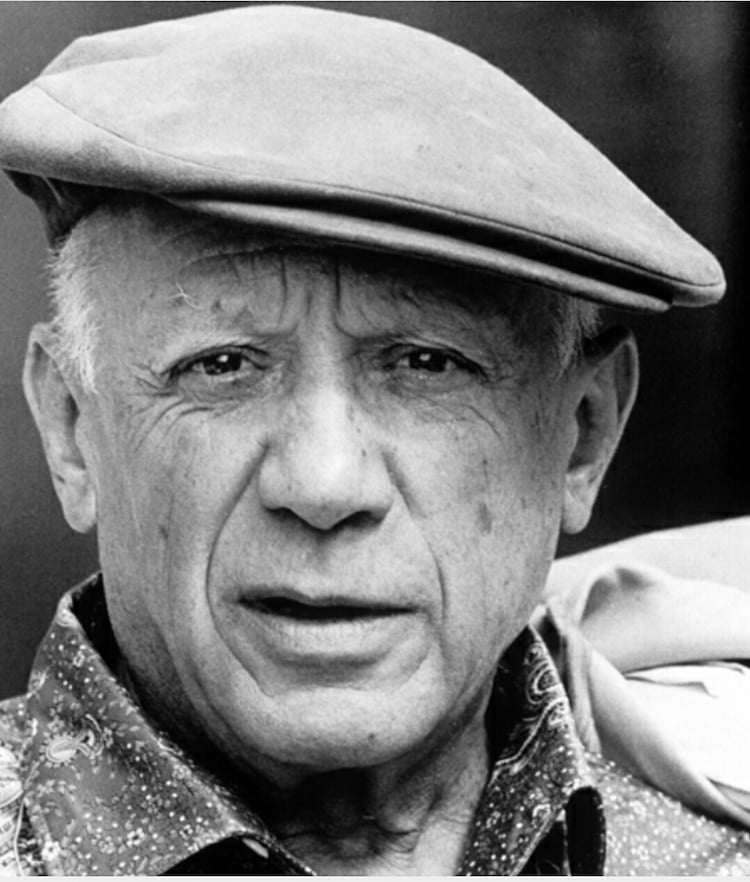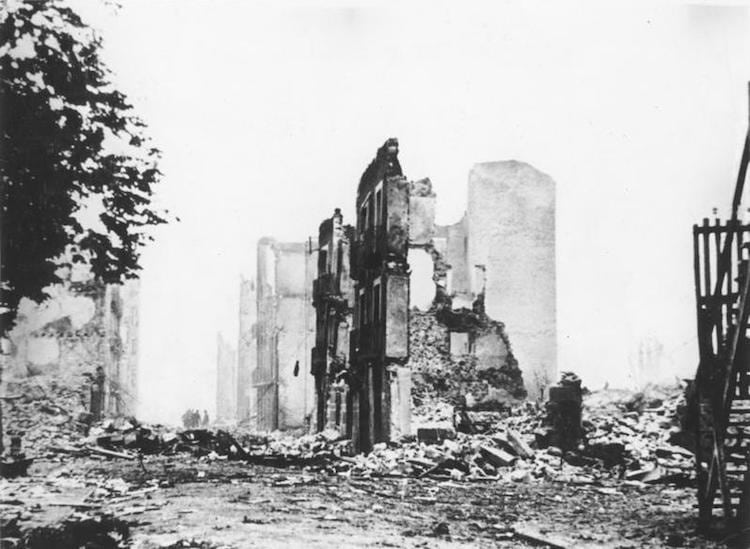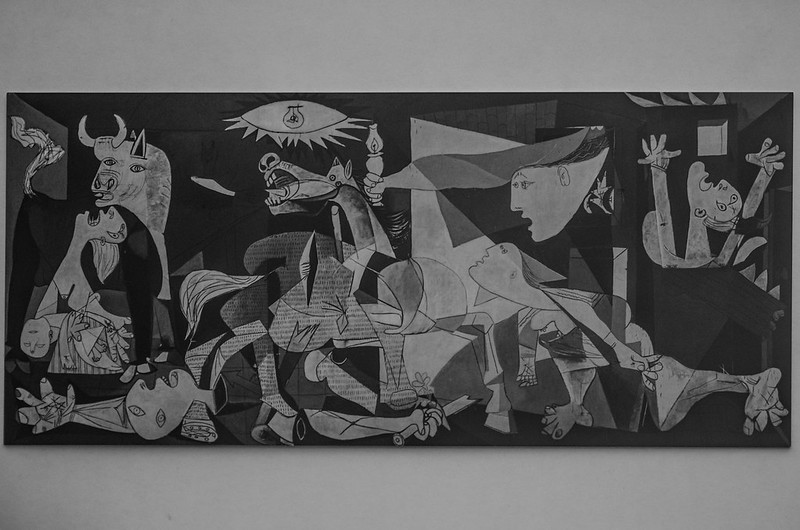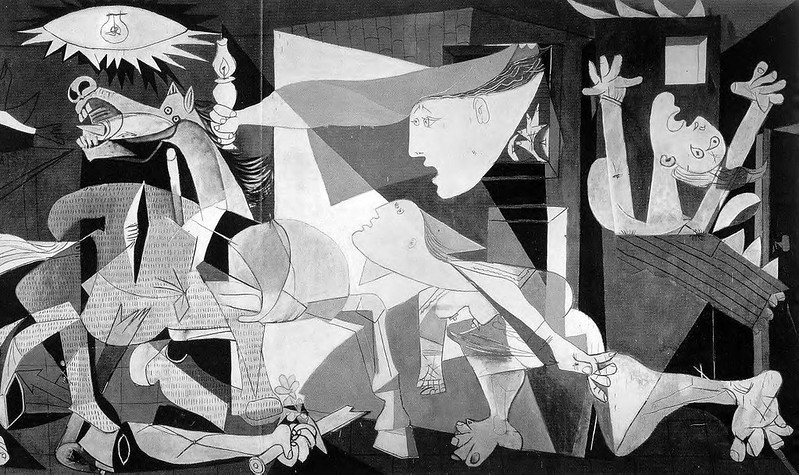Picasso and ‘Guernica’: Exploring the Anti-War Symbolism of This Famous Painting
As one of the most famous artists in Western art history, Pablo Picasso is known for his remarkably prolific career that spanned 79 years and included multiple disciplines. In particular, his paintings went through several stylistic evolutions like Cubism and Surrealism, reflecting the artist's lifelong need to push boundaries. And while many of Picasso's paintings are remembered for their trailblazing appearances, only one is known for its powerful anti-war message: the 1937 painting, Guernica.
At about 11 feet tall and 25 feet across, this massive work is visually arresting for its scale, composition, and unusual grayscale palette. Its dark subject matter was fueled by the Nazi bombing on the Basque town of Guernica in Northern Spain during the Spanish Civil War. The work was later used by the Spanish government to help raise awareness of the war and raise necessary funds.
Here, we will learn more about the historical context in which Guernica was made before analyzing the anti-war symbolism within the painting.
Who was Picasso?

Photograph of Pablo Picasso, 1962 (Photo: Public domain via Wikimedia Commons)
Picasso (1881 – 1973) was a Spanish child prodigy who began his creative career at the age of thirteen. As he continued making art, his realist, academic approach to painting waned, while other more imaginative styles became increasingly prominent. His body of work can be traced through eight different periods: realist, the Blue Period, the Rose Period, African, Cubism, Surrealism, Neoclassicism, and later work. Picasso used each of these distinct approaches to explore aesthetics, figurative subjects, emotions, and reality. He is considered to be one of the most influential figures of modern art.
Commissioning Guernica and Its Historical Context

Photograph of the Guernica ruins, 1937 (Photo via Wikimedia Commons, CC BY-SA 3.0 de)
In 1937, Picasso—who was living and working in France—was commissioned by the Spanish Republican government to create a work of art for the Spanish pavilion at the upcoming World's Fair in Paris.
During this time, Spain was in the midst of a civil war between the Republicans and the Nationalists. The Basque town of Guernica was one of the bases of the Republican movement, as well as a center of Basque culture. Due to this, the town was targeted by the Nazi-assisted Nationalists and bombed on April 26, 1937, for two hours.
Soon after the tragedy, Picasso was encouraged by a close friend to make the bombing the subject of the commission. Picasso immersed himself in the reports of the atrocities and, horrified by the state of his home country, began working on a large-scale painting based on the event.
The piece was completed in just 35 days.
Analysis of Guernica
Composition
Since the commission was originally intended to be a mural for the World's Fair, Guernica was conceived as a very large painting on canvas (about 11 feet by 25 feet). Picasso opted for matte house paint so that the piece would have little-to-no gloss, and he chose a limited palette of black, grays, and white to imitate the effect of black-and-white photography.
Guernica depicts the aftermath of the bombing within one contained space. From left to right: a distraught mother grieves over her dead child; a bull looms over her shoulder with a vacant or shocked expression; an injured horse cries out in pain while a dead soldier is trapped underneath his body; two women look over the scene in a stupor; and another woman is trapped in a fire and screaming.
Style
As a part of Picasso's later work, Guernica exhibits qualities of different stylistic periods, but most notably, cubist and surrealist characteristics. The array of different human and animal subjects is spread across the entirety of the canvas, their forms distorted into dreamlike versions of themselves. Most of the figures overlap one another, creating more shapes and narratives within these extra spaces.
Symbolism
While the anti-war message of Guernica is clear, the specifics of the painting's symbolism are still debated among art historians. The bull and the horse, for example, are both prominent subjects in Picasso's oeuvre but have also been theorized to be important characters that perhaps embody people or ideals.
Others have pointed out that the use of grayscale gives the impression of desolation and torment and the crowded, chaotic composition signifies oppression. Likewise, the twisting forms of the bodies have been interpreted as a protest in the face of adversity, the fire is seen as the destructive power of war, and the dismembered arm holding the broken sword is representative of the people's defeat.
Picasso said of the painting's symbolism: “It isn't up to the painter to define the symbols. Otherwise, it would be better if he wrote them out in so many words! The public who look at the picture must interpret the symbols as they understand them.”
Legacy of Guernica
After Guernica‘s completion, it was used during the World Fair to raise awareness of the Spanish Civil War. Later, the painting was sent to the United States to help raise funds for Spanish refugees. Picasso said that Guernica should only be returned to Spain once it had reestablished a republic. Finally, in 1981, the monumental piece was transferred back to its home country.
Today, it can be seen at the Reina Sofía Museum in Madrid.
Related Articles:
10 Surprising Facts About Pablo Picasso
The Evolution of Picasso’s Painting Style and What Each Artistic Choice Represents
9 Facts About Picasso‘s Groundbreaking Painting ‘Les Demoiselles d'Avignon'
READ: Picasso and ‘Guernica’: Exploring the Anti-War Symbolism of This Famous Painting






0 Commentaires